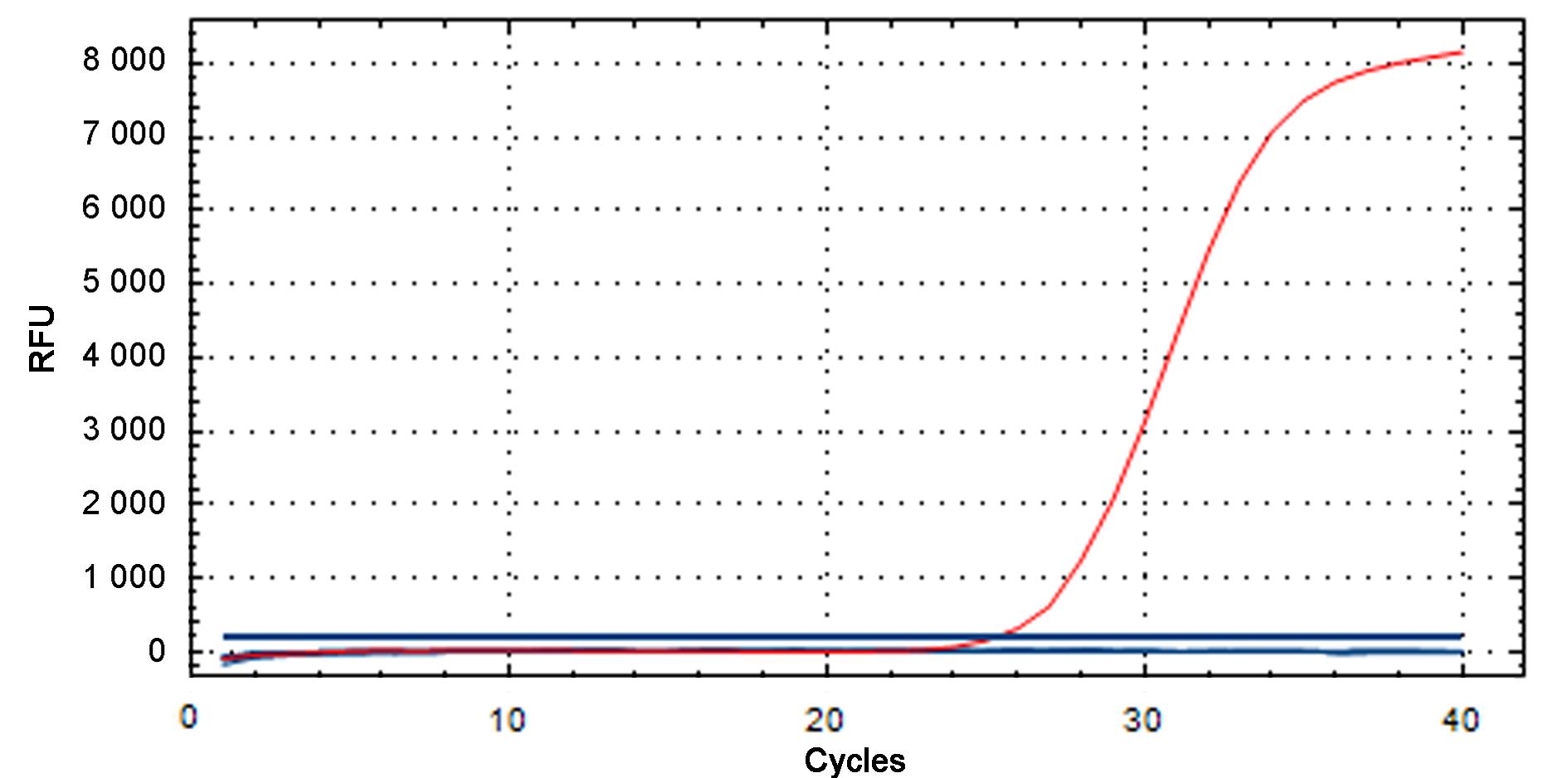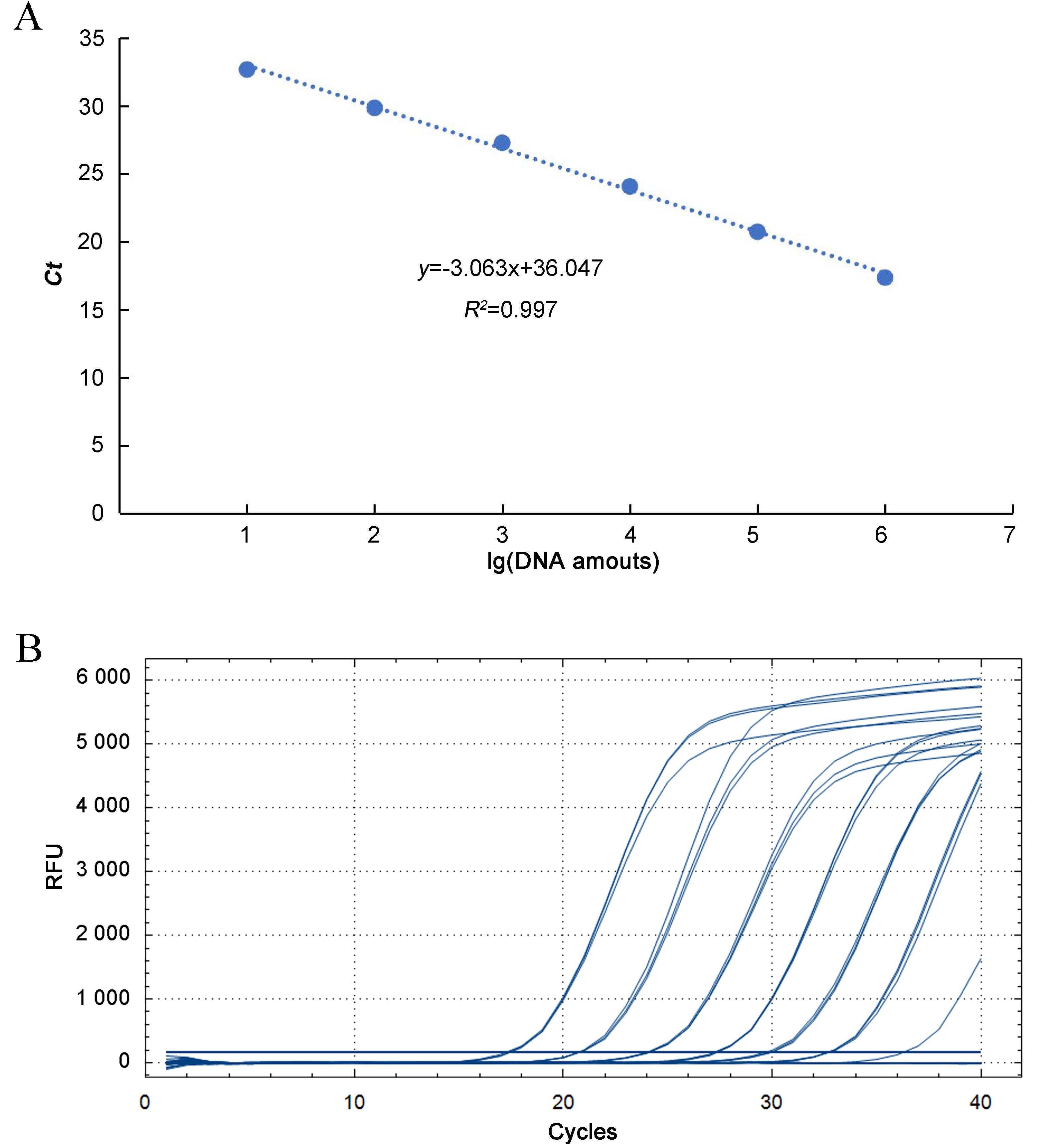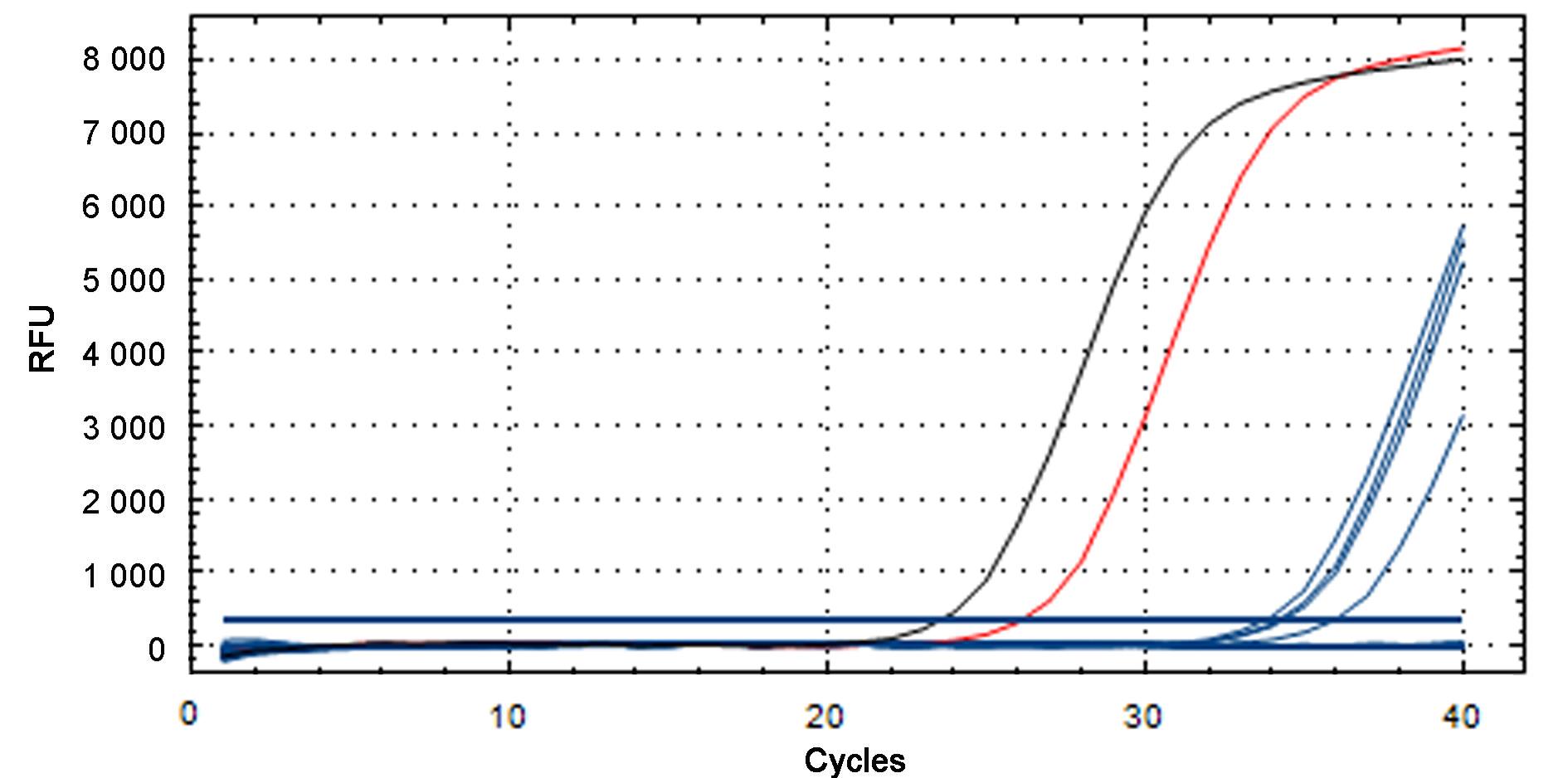
Laboratory Animal and Comparative Medicine ›› 2023, Vol. 43 ›› Issue (5): 566-573.DOI: 10.12300/j.issn.1674-5817.2023.022
• Research Reports • Previous Articles Next Articles
Lingzhi YU, Jianyun XIE, Liping FENG, Xiaofeng WEI( )(
)( )
)
Received:2023-02-20
Revised:2023-05-30
Online:2023-10-25
Published:2023-10-25
Contact:
Xiaofeng WEI
CLC Number:
Lingzhi YU,Jianyun XIE,Liping FENG,et al. Establishment of Fluorescence qPCR Method for Detection of Staphylococcus Aureus and Its Application in Feces Detection of Rats and Mice[J]. Laboratory Animal and Comparative Medicine, 2023, 43(5): 566-573. DOI: 10.12300/j.issn.1674-5817.2023.022.
Add to citation manager EndNote|Ris|BibTeX
URL: https://www.slarc.org.cn/dwyx/EN/10.12300/j.issn.1674-5817.2023.022

Figure 1 Specificity for Staphylococcus aureus detected by real-time fluorescent quantitative PCRNote:Red S-type curve represents the positive control.RFU, Relative fluorescence unit.

Figure 2 Standard curve (A) and sensitivity (B) for Staphylococcus aureus detected by real-time fluorescent quantitative PCRNote:The amounts of nucleic acid represented by the curves from left to right is 1 ng, 100 pg, 10 pg, 1 pg, 100 fg, 10 fg and 1 fg, respectively.
DNA量 DNA quantities | 10次检测结果(Ct值) 10 test results (Ct value) | CV值/% CV value/% | ||||||||||
|---|---|---|---|---|---|---|---|---|---|---|---|---|
| 1 | 2 | 3 | 4 | 5 | 6 | 7 | 8 | 9 | 10 | |||
| 10 pg | 25.23 | 25.17 | 24.99 | 25.23 | 25.16 | 25.04 | 25.2 | 25.15 | 25.16 | 25.21 | 0.33 | |
| 10 fg | 33.32 | 33.93 | 34.33 | 34.72 | 33.77 | 33.68 | 33.56 | 33.93 | 33.84 | 34.18 | 1.18 | |
Table 1 Intragroup repeatability data (Ct) and coefficient of variation (CV)
DNA量 DNA quantities | 10次检测结果(Ct值) 10 test results (Ct value) | CV值/% CV value/% | ||||||||||
|---|---|---|---|---|---|---|---|---|---|---|---|---|
| 1 | 2 | 3 | 4 | 5 | 6 | 7 | 8 | 9 | 10 | |||
| 10 pg | 25.23 | 25.17 | 24.99 | 25.23 | 25.16 | 25.04 | 25.2 | 25.15 | 25.16 | 25.21 | 0.33 | |
| 10 fg | 33.32 | 33.93 | 34.33 | 34.72 | 33.77 | 33.68 | 33.56 | 33.93 | 33.84 | 34.18 | 1.18 | |
DNA量 DNA quantities | 5次检测结果(Ct值) 5 test results(Ct value) | DNA量 DNA quantities | 5次检测结果(Ct值) 5 test results(Ct value) | ||||||||
|---|---|---|---|---|---|---|---|---|---|---|---|
| 1 | 2 | 3 | 4 | 5 | 1 | 2 | 3 | 4 | 5 | ||
| 10 pg | 33.13 | 34.08 | 36.00 | 34.19 | 33.02 | 10 fg | 26.04 | 26.10 | 26.20 | 26.12 | 26.08 |
| 34.44 | 32.27 | 33.47 | 34.04 | 34.56 | 25.80 | 25.89 | 25.83 | 26.15 | 26.10 | ||
| 32.72 | 32.60 | 32.35 | 31.90 | 32.56 | 26.17 | 25.39 | 25.86 | 25.76 | 25.91 | ||
| 32.13 | 32.88 | 34.21 | 33.14 | 32.90 | 25.87 | 25.96 | 25.86 | 25.90 | 25.66 | ||
| 33.83 | 35.05 | 32.60 | 33.99 | 33.41 | 25.86 | 25.78 | 26.10 | 26.12 | 25.69 | ||
平均数1 Mean 1 | 33.25 | 33.38 | 33.73 | 33.45 | 33.29 | 25.95 | 25.82 | 25.97 | 26.01 | 25.89 | |
平均数2 Mean 2 | 33.42 | 25.93 | |||||||||
| 标准差SD | 0.19 | 0.19 | |||||||||
| CV/% | 0.56 | 0.75 | |||||||||
Table 2 Intergroup repeatability data (Ct) and coefficient of variation(CV)
DNA量 DNA quantities | 5次检测结果(Ct值) 5 test results(Ct value) | DNA量 DNA quantities | 5次检测结果(Ct值) 5 test results(Ct value) | ||||||||
|---|---|---|---|---|---|---|---|---|---|---|---|
| 1 | 2 | 3 | 4 | 5 | 1 | 2 | 3 | 4 | 5 | ||
| 10 pg | 33.13 | 34.08 | 36.00 | 34.19 | 33.02 | 10 fg | 26.04 | 26.10 | 26.20 | 26.12 | 26.08 |
| 34.44 | 32.27 | 33.47 | 34.04 | 34.56 | 25.80 | 25.89 | 25.83 | 26.15 | 26.10 | ||
| 32.72 | 32.60 | 32.35 | 31.90 | 32.56 | 26.17 | 25.39 | 25.86 | 25.76 | 25.91 | ||
| 32.13 | 32.88 | 34.21 | 33.14 | 32.90 | 25.87 | 25.96 | 25.86 | 25.90 | 25.66 | ||
| 33.83 | 35.05 | 32.60 | 33.99 | 33.41 | 25.86 | 25.78 | 26.10 | 26.12 | 25.69 | ||
平均数1 Mean 1 | 33.25 | 33.38 | 33.73 | 33.45 | 33.29 | 25.95 | 25.82 | 25.97 | 26.01 | 25.89 | |
平均数2 Mean 2 | 33.42 | 25.93 | |||||||||
| 标准差SD | 0.19 | 0.19 | |||||||||
| CV/% | 0.56 | 0.75 | |||||||||

Figure 3 Clinical detection results for Staphylococcus aureus by real-time fluorescent quantitative PCR detectionNote:The red S curve represents the positive control for amplification, the black S curve represents the positive control for nucleic acid extraction, and the four blue S curves represent the positive samples.
| 1 | AHMAD-MANSOUR N, LOUBET P, POUGET C, et al. Staphylococcus aureus toxins: an update on their pathogenic properties and potential treatments[J]. Toxins, 2021, 13(10):677. DOI: 10.3390/toxins13100677 . |
| 2 | HOWDEN B P, GIULIERI S G, WONG FOK LUNG T, et al. Staphylococcus aureus host interactions and adaptation[J]. Nat Rev Microbiol, 2023, 21(6):380-395. DOI: 10.1038/s41579-023-00852-y . |
| 3 | TUON F F, SUSS P H, TELLES J P, et al. Antimicrobial treatment of Staphylococcus aureus biofilms[J]. Antibiotics (Basel), 2023, 12(1):87. DOI: 10.3390/antibiotics12010087 . |
| 4 | 国家市场监督管理总局, 中国国家标准化管理委员会. 实验动物 微生物、寄生虫学等级及监测: GB 14922—2022[S]. 北京: 中国标准出版社, 2022. |
| State Administration for Market Regulation; Standardization Administration of the People's Republic of China. Laboratory animals—Microbiological and parasitical standards and monitoring: GB 14922-2022[S]. Beijing: Standards Press of China, 2022. | |
| 5 | 中华人民共和国国家质量监督检验检疫总局, 中国国家标准化管理委员会.实验动物微生物学检测方法: GB/T 14926—2001[S]. 北京: 中国标准出版社, 2022. |
| General Administration of Quality Supervision, Inspection and Quarantine; Standardization Administration of the People's Republic of China. Laboratory animals—Microbiological examination methods: GB/T 14926-2001[S]. Beijing: Standards Press of China, 2001. | |
| 6 | 翟俊辉, 宋亚军, 杜宗敏, 等. 通用基因芯片检测感染性细菌方法的研究[J]. 中国公共卫生, 2003, 19(4): 430-431. DOI: 10.3321/j.issn: 1001-0580.2003.04.021 . |
| ZHAI J H, SONG Y J, DU Z M, et al. Study on universal microarray system for detection of common clinical infectious bacteria[J]. China J Public Health, 2003, 19(4): 430-431.DOI: 10.3321/j.issn: 1001-0580.2003.04.021 . | |
| 7 | STRAUB J A, HERTEL C, HAMMES W P. A 23S rDNA-targeted polymerase chain reaction-based system for detection of Staphylococcus aureus in meat starter cultures and dairy products[J]. J Food Prot, 1999, 62(10):1150-1156. DOI: 10.4315/0362-028x-62.10.1150 . |
| 8 | ONO H K, HIROSE S, NAITO I, et al. The emetic activity of staphylococcal enterotoxins, SEK, SEL, SEM, SEN and SEO in a small emetic animal model, the house musk shrew[J]. Microbiol Immunol, 2017, 61(1):12-16. DOI: 10.1111/1348-0421.12460 . |
| 9 | KRONING I S, IGLESIAS M A, MENDONÇA K S, et al. Presence of classical enterotoxin genes, agr typing, antimicrobial resistance, and genetic diversity of Staphylococcus aureus from milk of cows with mastitis in southern Brazil[J]. J Food Prot, 2018, 81(5):738-742. DOI: 10.4315/0362-028X.JFP-17-436 . |
| 10 | MATSUDA K, TSUJI H, ASAHARA T, et al. Sensitive quantitative detection of commensal bacteria by rRNA-targeted reverse transcription-PCR[J]. Appl Environ Microbiol, 2007, 73(1):32-39. DOI: 10.1128/aem.01224-06 . |
| 11 | 王敏, 范婧, 李先平. PCR扩增法检测耐甲氧西林金黄色葡萄球菌的mecA基因[J]. 广东医学, 2008, 29(4):566-568. DOI: 10.3969/j.issn.1001-9448.2008.04.015 . |
| WANG M, FAN J, LI X P. Detection of mecA gene in methicillin-resistant Staphylococcus aureus by PCR amplification[J]. Guangdong Medical Journal, 2008, 29(4):566-568. DOI: 10.3969/j.issn.1001-9448.2008.04.015 . | |
| 12 | 杨波. MecA基因聚合酶链反应扩增法与细菌鉴定仪法对耐甲氧西林金黄色葡萄球菌的鉴定比较及药敏分析[J]. 实用医技杂志, 2017, 24(2):141-142. DOI: 10.19522/j.cnki.1671-5098.2017.02.007 . |
| YANG B. Comparison and drug sensitivity analysis of methicillin-resistant Staphylococcus aureus by MecA gene polymerase chain reaction amplification method and bacterial identification instrument method[J]. Journal of Practical Medical Techniques, 2017, 24(2):141-142. DOI: 10.19522/j.cnki.1671-5098.2017.02.007 . | |
| 13 | FAOUZI, BEKKAOUI, . Rapid detection of the mecA gene in methicillin resistant staphylococci using a colorimetric cycling probe technology[J]. Diagn Microbiol Infect Dis, 1999, 34(2):83-90. DOI: 10.1016/S0732-8893(99)00012-7 . |
| 14 | KOBAYASHI N, WU H, KOJIMA K, et al. Detection of mecA, femA, and femB genes in clinical strains of staphylococci using polymerase chain reaction[J]. Epidemiol Infect, 1994, 113(2):259-266. DOI: 10.1017/s0950268800051682 . |
| 15 | OU A F, WANG K, MAO Y X, et al. First report on the rapid detection and identification of methicillin-resistant Staphylococcus aureus (MRSA) in viable but non-culturable (VBNC) under food storage conditions[J]. Front Microbiol, 2021, 11:615875. DOI: 10.3389/fmicb.2020.615875 . |
| 16 | SHOAIB M, AQIB A I, ALI M M, et al. Tracking infection and genetic divergence of methicillin-resistant Staphylococcus aureus at pets, pet owners, and environment interface[J]. Front Vet Sci, 2022, 9:900480. DOI: 10.3389/fvets.2022.900480 . |
| 17 | HENNEKINNE J A, DE BUYSER M L, DRAGACCI S. Staphylococcus aureus and its food poisoning toxins: characterization and outbreak investigation[J]. FEMS Microbiol Rev, 2012, 36(4):815-836. DOI: 10.1111/j.1574-6976.2011.00311.x . |
| 18 | NADIYA S, KOLLA H B, REDDY P N. Optimization and evaluation of a multiplex PCR assay for detection of Staphylococcus aureus and its major virulence genes for assessing food safety[J]. Publ Braz Soc Microbiol, 2023, 54(1):311-321. DOI: 10.1007/s42770-023-00906-6 . |
| 19 | GONET M, KROWARSCH D, SCHUBERT J, et al. Stability and resistance to proteolysis of enterotoxins SEC and SEL produced by Staphylococcus epidermidis and Staphylococcus aureus [J]. Foodborne Pathog Dis, 2023, 20(1):32-37. DOI: 10.1089/fpd.2022.0059 . |
| 20 | MORADIKIAN M, KOMIJANI M, SHAYESTEHFAR A. Detection of Staphylococcus aureus and their toxin genes inhabit on the scorpions surface[J]. Arch Microbiol, 2022, 204(9):576. DOI: 10.1007/s00203-022-03176-2 . |
| 21 | SU Y C, WONG A C. Identification and purification of a new staphylococcal enterotoxin, H[J]. Appl Environ Microbiol, 1995, 61(4):1438-1443. DOI: 10.1128/aem.61.4.1438-1443.1995 . |
| 22 | MUNSON S H, TREMAINE M T, BETLEY M J, et al. Identification and characterization of staphylococcal enterotoxin types G and I from Staphylococcus aureus [J]. Infect Immun, 1998, 66(7):3337-3348. DOI: 10.1128/IAI.66. 7.3337-3348.1998 . |
| 23 | GERGOVA R, TSITOU V M, DIMOV S G, et al. Molecular epidemiology, virulence and antimicrobial resistance of Bulgarian methicillin resistant Staphylococcus aureus isolates[J]. AMicr, 2022, 69(3):193-200. DOI: 10.1556/030.2022. 01766 . |
| 24 | TUCKER P W, HAZEN E E Jr, COTTON F A. Staphylococcal nuclease reviewed: a prototypic study in contemporary enzymology. I. Isolation; physical and enzymatic properties[J]. Mol Cell Biochem, 1978, 22(2-3):67-77. DOI: 10.1007/BF00496235 . |
| 25 | BRAKSTAD O G, MÆLAND J A. Generation and characterization of monoclonal antibodies against Staphylococcus aureus thermonuclease[J]. APMIS, 1989, 97(1-6):166-174. DOI: 10.1111/j.1699-0463.1989.tb00772.x . |
| 26 | KOVACEVIC S, VEAL L E, HSIUNG H M, et al. Secretion of staphylococcal nuclease by Bacillus subtilis [J]. J Bacteriol, 1985, 162(2):521-528. DOI: 10.1128/jb.162.2.521-528.1985 . |
| 27 | CHESNEAU O, ALLIGNET J, SOLH N EL. Thermonuclease gene as a target nucleotide sequence for specific recognition of Staphylococcus aureus [J]. Mol Cell Probes, 1993, 7(4):301-310. DOI: 10.1006/mcpr.1993.1044 . |
| 28 | MADISON B M, BASELSKI V S. Rapid identification of Staphylococcus aureus in blood cultures by thermonuclease testing[J]. J Clin Microbiol, 1983, 18(3):722-724. DOI: 10.1128/jcm.18.3.722-724.1983 . |
| 29 | CANNING B, MOHAMED I, WICKRAMASINGHE N, et al. Thermonuclease test accuracy is preserved in methicillin-resistant Staphylococcus aureus isolates[J]. J Med Microbiol, 2020, 69(4):548-551. DOI: 10.1099/jmm.0.001166 . |
| 30 | 王纯, 张若鸿, 王晓芳, 等. 乳制品中金黄色葡萄球菌PCR快速检测方法的建立[J]. 核农学报, 2022, 36(6): 1193-1203. DOI: 10.11869/j.issn.100-8551.2022.06.1193 . |
| WANG C, ZHANG R H, WANG X F, et al. Development of PCR rapid detection method for Staphylococcus aureus in dairy products[J]. J Nucl Agric Sci, 2022, 36(6): 1193-1203. DOI: 10.11869/j.issn.100-8551.2022.06.1193 . | |
| 31 | DONG Q S, WANG Q, ZHANG Y, et al. Prevalence, antimicrobial resistance, and staphylococcal toxin genes of blaTEM-1a-producing Staphylococcus aureus isolated from animals in Chongqing, China[J]. Vet Med Sci, 2023, 9(1):513-522. DOI: 10.1002/vms3.1028 . |
| 32 | BRAKSTAD O G, AASBAKK K, MAELAND J A. Detection of Staphylococcus aureus by polymerase chain reaction amplification of the nuc gene[J]. J Clin Microbiol, 1992, 30(7):1654-1660. DOI: 10.1128/jcm.30.7.1654-1660.1992 . |
| 33 | 高正琴, 邢华, 李厚达. PCR技术在鼠金黄色葡萄球菌检测中的初步研究[J]. 畜牧与兽医, 2002, 34(8):5-7. DOI: 10.3969/j.issn.0529-5130.2002.08.003 . |
| GAO Z Q, XING H, LI H D. The pilot study of polymerase chain reaction for detecting Staphylococcus aureus in rats and mice[J]. Animal Husb Vet Med, 2002, 34(8):5-7. DOI: 10.3969/j.issn.0529-5130.2002.08.003 . | |
| 34 | 王鹏飞. 实验动物金黄色葡萄球菌、绿脓杆菌和肺支原体多重PCR检测方法的建立与初步应用[D]. 石家庄:河北医科大学,2016. |
| WANG P F. The Establishment and preliminary applications of Multiple PCR for detecting Staphylococcus aureus,Pseudomonas aeruginosa and Mycoplasma pulmonis in Laboratory Animals[D]. SHIJIAZHUANG: Hebei Medical University, 2016. | |
| 35 | 陆文俊. 金黄色葡萄球菌特异性靶点的筛选与PCR快速检测方法的建立[D]. 南京:南京农业大学, 2017. |
| LU W J. The screening of specific target for Staphylococcus aureus and establishment of rapid PCR detection method[D]. Nanjing: Nanjing Agriculture University. 2017. |
| [1] | LIU Yueqin, XUE Weiguo, WANG Shuyou, SHEN Yaohua, JIA Shuyong, WANG Guangjun, SONG Xiaojing. Observation of Digestive Tract Tissue Morphology in Mice Using Probe-Based Confocal Laser Endomicroscopy [J]. Laboratory Animal and Comparative Medicine, 2025, 45(4): 457-465. |
| [2] | QIN Chao, LI Shuangxing, ZHAO Tingting, JIANG Chenchen, ZHAO Jing, YANG Yanwei, LIN Zhi, WANG Sanlong, WEN Hairuo. Study on the 90-day Feeding Experimental Background Data of SD Rats for Drug Safety Evaluation [J]. Laboratory Animal and Comparative Medicine, 2025, 45(4): 439-448. |
| [3] | LIU Liyu, JI Bo, LIU Xiaoxuan, FANG Yang, ZHANG Ling, GUO Tingting, QUAN Ye, LI Hewen, LIU Yitian. Exploration of Rat Fetal Lung Tissue Fixation Methods [J]. Laboratory Animal and Comparative Medicine, 2025, 45(4): 432-438. |
| [4] | JIANG Meng, HAO Shulan, TONG Liguo, ZHONG Qiming, GAO Zhenfei, WANG Yonghui, WANG Xixing, JI Haijie. Dynamic Evaluation of Vinorelbine-Induced Phlebitis of Dorsalis Pedis Vein in a Rat Model [J]. Laboratory Animal and Comparative Medicine, 2025, 45(3): 251-258. |
| [5] | KONG Zhihao, WEI Xiaofeng, YU Lingzhi, FENG Liping, ZHU Qi, SHI Guojun, WANG Chen. Isolation and Identification of Staphylococcus xylosus in Nude Mice with Squamous Skin Scurfs [J]. Laboratory Animal and Comparative Medicine, 2025, 45(3): 368-375. |
| [6] | PAN Yicong, JIANG Wenhong, HU Ming, QIN Xiao. Optimization of Surgical Procedure and Efficacy Evaluation of Aortic Calcification Model in Rats with Chronic Kidney Disease [J]. Laboratory Animal and Comparative Medicine, 2025, 45(3): 279-289. |
| [7] | LIU Zhiwei, YANG Ran, LIAN Hao, ZHANG Yu, JIN Lilun. Cartilage Protection and Anti-Inflammatory Effects of Fraxetin on Monosodium Iodoacetate-Induced Rat Model of Osteoarthritis [J]. Laboratory Animal and Comparative Medicine, 2025, 45(3): 259-268. |
| [8] | LIAN Hui, JIANG Yanling, LIU Jia, ZHANG Yuli, XIE Wei, XUE Xiaoou, LI Jian. Construction and Evaluation of a Rat Model of Abnormal Uterine Bleeding [J]. Laboratory Animal and Comparative Medicine, 2025, 45(2): 130-146. |
| [9] | XU Qiuyu, YAN Guofeng, FU Li, FAN Wenhua, ZHOU Jing, ZHU Lian, QIU Shuwen, ZHANG Jie, WU Ling. A Mouse Model of Polycystic Ovary Syndrome Established Through Subcutaneous Administration of Letrozole Sustained-Release Pellets and Hepatic Transcriptome Analysis [J]. Laboratory Animal and Comparative Medicine, 2025, 45(2): 119-129. |
| [10] | WU Zhihao, CAO Shuyang, ZHOU Zhengyu. Establishment of an Intestinal Fibrosis Model Associated with Inflammatory Bowel Disease in VDR-/- Mice Induced by Helicobacter hepaticus Infection and Mechanism Exploration [J]. Laboratory Animal and Comparative Medicine, 2025, 45(1): 37-46. |
| [11] | ZHANG Nan, LI Huaiyin, LIAN Xiaodi, WEI Juanpeng, GAO Ming. Effects of Different Durations of Light Exposure on Body Weight and Learning and Memory Abilities of NIH Mice [J]. Laboratory Animal and Comparative Medicine, 2025, 45(1): 73-78. |
| [12] | LIU Rongle, CHENG Hao, SHANG Fusheng, CHANG Shufu, XU Ping. Study on Cardiac Aging Phenotypes of SHJH hr Mice [J]. Laboratory Animal and Comparative Medicine, 2025, 45(1): 13-20. |
| [13] | ZHAO Xiaona, WANG Peng, YE Maoqing, QU Xinkai. Establishment of a New Hyperglycemic Obesity Cardiac Dysfunction Mouse Model with Triacsin C [J]. Laboratory Animal and Comparative Medicine, 2024, 44(6): 605-612. |
| [14] | YIN Yulian, MA Lina, TU Siyuan, CHEN Ling, YE Meina, CHEN Hongfeng. Establishment and Evaluation of a Rat Model of Non-Puerperal Mastitis [J]. Laboratory Animal and Comparative Medicine, 2024, 44(6): 587-596. |
| [15] | TAN He, YANG Xiaohui, ZHANG Daxiu, WANG Guicheng. Optimal Adaptation Period for Metabolic Cage Experiments in Mice at Different Developmental Stages [J]. Laboratory Animal and Comparative Medicine, 2024, 44(5): 502-510. |
| Viewed | ||||||
|
Full text |
|
|||||
|
Abstract |
|
|||||